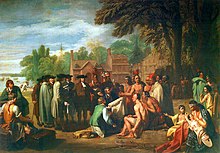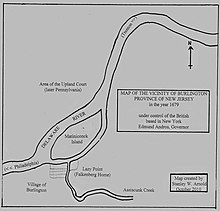Hendrick Jacobs Falkenberg
He was a linguist, fluent in the language of the Lenape Native Americans, and in early histories of New Jersey he is noted for his service to both the Indians and the English Quakers, helping them negotiate land transactions.
[1] He later moved to the vicinity of Burlington, New Jersey where he lived for nearly two decades, and where he was visited by two journalists of the Labadist sect who were looking for a place to establish a new community.
In colonial records of New Jersey the name of Hendrick Jacobs Falkenberg occurs frequently in land transactions where he acted as interpreter between the native Lenape and European settlers.
The first public record found for Falkenberg was a deed dated October 12, 1672, when he was named as an heir of "Seneca Brewer" (Sennick Broer).
In 1671, when the English made a census of the inhabitants of the Delaware River, Hendrick Jacobs was likely living with his wife and brothers-in-law on property belonging to his father-in-law, Sennick Broer.
This 900-acre tract was called "Deer Point" and located on the north side of the Christina River, later a part of Wilmington, Delaware.
[4] The length of his stay at Deer Point is unknown, but by 1674 Jacobs was living 44 miles to the northeast, upstream along the Delaware River on an island called Mattiniconck (or Matinicum), adjacent to what would become the town of Burlington, New Jersey.
"[16][17][c] On November 14, 1678, Robert Stacy, one of the Yorkshire commissioners of the Burlington Colony, obtained a lease for this island from Governor Edmund Andros of New York.
[18][19] However, on December 5, 1678, twenty-nine Quaker residents of Burlington petitioned the Governor because Jacobs had been of great service for them as interpreter and acquiring land from the Lenape.
[5][6] While the immediate outcome of the litigation is not known, ultimately the West Jersey assembly passed an act in 1682 vesting possession of the island to the town of Burlington with rents to be used for school maintenance and education of youth.
[7] Jacobs likely resided at this location because on August 8, 1685, he sold this property, with dwelling house, to Noel Mew of Rhode Island.
[9] Jegou purchased this property in 1668 and was operating an inn there in 1670 when he was plundered by Natives, subsequently leaving the area for Deer Point on the Christina River.
[4] A map copied by Jasper Danckaerts shows this property of Hendrick Jacobs as lying on the Delaware River across a small branch, Assiscunk Creek, near the town of Burlington, New Jersey.
[22] In 1679 Danckaerts and his partner Peter Sluyter, two envoys of the Labadist religious sect, came from the Netherlands to America to find a location to establish a community, their journey extending from New York southward to Maryland.
We, therefore, rowed on to the village, in search of lodgings, for it had been dark all of an hour or more; but proceeding a little further, we met this Jacob Hendrix, in a canoe with hay.
As we were now at the village, we went up to the tavern, but there were no lodgings to be obtained there, whereupon we reembarked in the boat, and rowed back to Jacob Hendrix's, who received us very kindly, and entertained us according to his ability.
[4] On January 26, 1691/92, he witnessed the will of Gilbert Morrell of Steatley, Burlington County, New Jersey, his name then being recorded as "Hinrich Jacobsen Falckenberg.
[9] On April 11, 1697, a deed was drafted confirming the 1674 offering by Lenape of land at Little Egg Harbor, his name being recorded in the 1697 document as "Henery Jacobs Faukinburge.
For about seventy years after the settlement of Little Egg Harbor, the Friends were the only religious denomination in the township and their meeting house is where most who lived in the area worshipped.
[37] The last public record found for Hendrick Jacobs Falkenberg was dated October 1, 1711, when he bought land at Little Egg Harbor from John Cooke.
For unknown reasons, the instrument was not presented for probate until thirty-three years after its writing, June 7, 1743, long after Falkenberg's death, when John Wills appeared in court as the only surviving witness.
^ Peter Jegou lived at Deer Point until 1683 and then moved to Cecil County, Maryland where his will was proved on April 1, 1687, mentioning no descendants.


